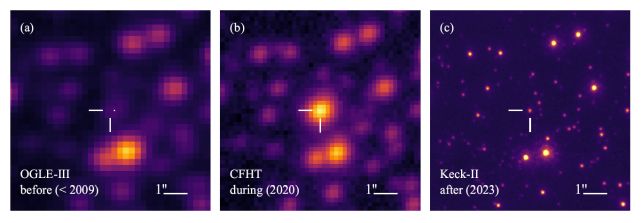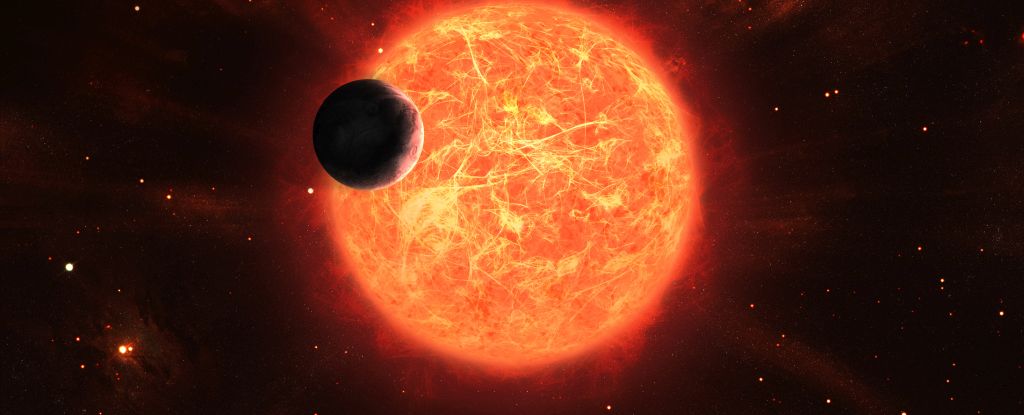Products You May Like
The hunt is on for a second Earth, somewhere out there in the Milky Way galaxy, but a newly discovered world is not quite the thing.
It comes in at around 1.9 times the mass of Earth, orbiting its star at around twice Earth’s distance from the Sun… but that star is a white dwarf, which means any life that might have been on the exoplanet was probably obliterated before or during the star’s red giant death throes.
But the discovery is an exciting one, nevertheless: it’s like getting a sneak peek at the future of the Solar System, and the fate of Earth, once the Sun dies and completes its own evolution into a white dwarf.
And the work, led by astronomer Keming Zhang of the University of California, shows the potential for the way it was discovered – a phenomenon known as microlensing – to locate other hard-to-find Earth-like worlds elsewhere in the galaxy.
White dwarfs are what stars like the Sun turn into when they die. They run out of hydrogen fuel to fuse in their cores and become less stable, puffing up to an enormous size. That’s the red giant phase.
Eventually, the star will eject its outer material completely, and the core will collapse under gravity to form a dense object, its bright light not generated by fusion, but the residual heat of its collapse process. That hot core is the white dwarf, and it will take trillions of years to cool to complete darkness.
The red giant phase is pretty crazy. The star’s outer atmosphere can expand to hundreds of times its initial size; some projections of the Sun’s future – due to start becoming a red giant in about 5 billion years or so – predict it could grow as large as out to the orbit of Mars, engulfing Mercury, Venus, and Earth in the process.
We don’t know what this will mean for our planet. Its destruction is possible. But this new discovery of an Earth-like world orbiting a white dwarf suggests that survival is also an option.
“The simplest explanation is that the planet survived through the red giant host star,” Zhang told ScienceAlert.
The system was discovered due to a quirk of gravity and the positions of things in space known as microlensing. The white dwarf system is about 4,200 light-years away. About 26,100 light-years away, along the same line of sight from Earth, a very large, bright star briefly lined up.
As the light from the more distant star traveled past the white dwarf, its path was curved by the gravitational field, resulting in a magnification effect.

“The white dwarf lens was nearly perfectly aligned with the background source star during the event, causing it to be magnified by over 1,000 times,” Zhang explained.
“For these rare ultra high magnification microlensing events, a companion as small as a terrestrial planet could significantly affect the magnification pattern, enabling us to accurately infer the lens configuration across a wide range of masses and orbital separations.”
This allowed the researchers to not just determine the mass and orbital separation of the Earth-like, or terrestrial, exoplanet, but the presence of a brown dwarf orbiting the white dwarf, too, an object about 30 times the mass of Jupiter.
It’s a sort of weird in-between that’s too big for a planet, but too small for a star – just massive enough to fuse deuterium in its core, but not massive enough for the hydrogen fusion that defines a star.
The white dwarf is around half the mass of the Sun, suggesting that it was originally pretty close to the mass of the Sun before it kablooeyed its guts out. And the current orbital separation between the terrestrial exoplanet and the white dwarf suggests it was once at around the same distance Earth is from the Sun, 1 astronomical unit, before being pushed farther out as the star died.
“The planet’s current orbit of 2.1 astronomical units is around exactly where you would expect to find planet Earth after the Sun has become a white dwarf,” Zhang told ScienceAlert.
“Models currently disagree whether or not Earth can avoid being engulfed because we do not know the mass loss rate of the red giant sun precisely enough. Thus our discovery suggests some of the models predicting against Earth’s survival may be too pessimistic. At the end of the day Earth may just narrowly escape being engulfed similar to our discovered system.”
Life on Earth will either be long gone, or dramatically different, by the time the Sun’s red giant phase rolls around. The Sun is growing hotter and brighter over time – not enough that we’d notice it in the here and now, but in about a billion years, it will be so hot that all the water on Earth will evaporate. The world that’s left will be deeply inhospitable to life as we know it.
But maybe by that time, we’ll have found a way to make a life elsewhere.
“As the Sun becomes a red giant, the habitable zone will move to around Jupiter and Saturn‘s orbit, and many of these moons will become ocean planets,” Zhang said. “I think, in that case, humanity could migrate out there.”
The team’s research has been published in Nature Astronomy.
